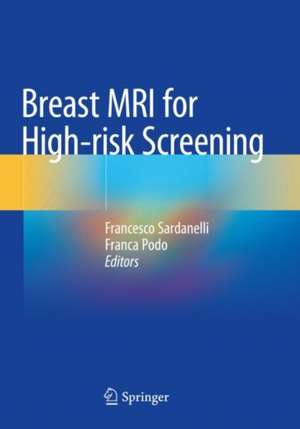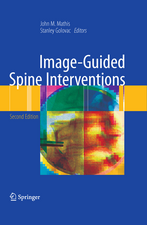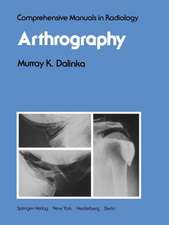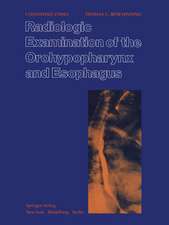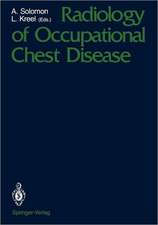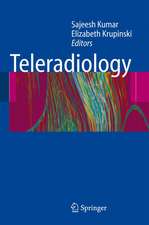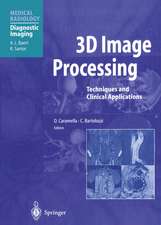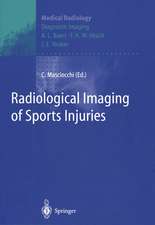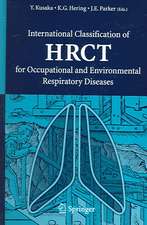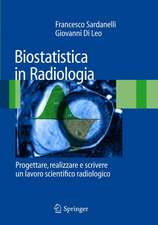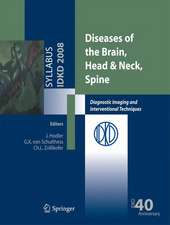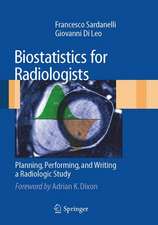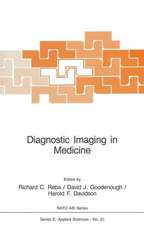Breast MRI for High-risk Screening
Editat de Francesco Sardanelli, Franca Podoen Limba Engleză Paperback – 14 oct 2021
This book offers a comprehensive overview of the use of breast MRI for screening high-risk women, including those with familial-genetic hereditary predisposition and previous chest radiation therapy, typically lymphoma survivors. It discusses the historical background of studies and research that provided the body of evidence in favor of MRI screening of these women. Technical and clinical topics are treated in dedicated chapters, including models for individualized risk estimation, radiogenomics of breast cancer in high-risk women, computer-aided detection/diagnosis and machine learning systems applied to breast MRI, and psycho-oncology issues. Alternatives to breast MRI screening such as pharmaco-prevention and prophylactic mastectomy are also discussed, taking into account the public debate on the “Angelina Jolie” effect. The high breast cancer risk model is proposed as a paradigm for personalized medicine. This book will be of interest to radiologists, surgeons, oncologists and to all professionals devoted to female healthcare.
| Toate formatele și edițiile | Preț | Express |
|---|---|---|
| Paperback (1) | 620.70 lei 38-44 zile | |
| Springer International Publishing – 14 oct 2021 | 620.70 lei 38-44 zile | |
| Hardback (1) | 866.17 lei 38-44 zile | |
| Springer International Publishing – 14 oct 2020 | 866.17 lei 38-44 zile |
Preț: 620.70 lei
Preț vechi: 653.36 lei
-5% Nou
Puncte Express: 931
Preț estimativ în valută:
118.79€ • 123.56$ • 98.06£
118.79€ • 123.56$ • 98.06£
Carte tipărită la comandă
Livrare economică 10-16 aprilie
Preluare comenzi: 021 569.72.76
Specificații
ISBN-13: 9783030412098
ISBN-10: 3030412091
Pagini: 376
Ilustrații: XXIII, 376 p. 84 illus., 32 illus. in color.
Dimensiuni: 178 x 254 mm
Greutate: 0.86 kg
Ediția:1st ed. 2020
Editura: Springer International Publishing
Colecția Springer
Locul publicării:Cham, Switzerland
ISBN-10: 3030412091
Pagini: 376
Ilustrații: XXIII, 376 p. 84 illus., 32 illus. in color.
Dimensiuni: 178 x 254 mm
Greutate: 0.86 kg
Ediția:1st ed. 2020
Editura: Springer International Publishing
Colecția Springer
Locul publicării:Cham, Switzerland
Cuprins
Introduction.- Thirty years of contrast enhanced breast MRI.- The mantra about low specificity breast MRI.- BRCA and other genes conferring hereditary breast cancer predisposition.- Screening mammography: One size fits all?.- MRI protocols for breast cancer screening.- Contrast materials for screening MRI and concerns about tissue deposition.- Applying MRI BI-RADS in a high-risk population.- CAD systems for breast MRI screening.- Phenotype presentation and radiogenomics of breast cancer with special focus on high-risk women.- The body of primary evidence about MRI for high risk screening: retrospective and prospective studies.- High-risk screening: MRI alone?.- Secondary evidence from systematic reviews and meta-analyses.- Radioprotection issues for women with hereditary predisposition for breast cancer.- Impact of MRI screening on high-risk patient outcome.- The special case of previous chest radiation therapy.- IT infrastructure for data managing in multicenter high-risk screening.- Guidelines and recommendations all over the world: agreements and differences.- Medical options: Pharmacopreventio- Surgical options: Prophylactic mastectomy and oophorectomy.- Psychosocial aspects of high-risk of breast cancer.- Calculating, using and improving individual breast cancer risk estimates.- MRI for screening women with a personal history of breast cancer.- Screening MRI for the intermediate risk: an open issue.- Looking at the future: Personalized breast cancer screening.- Acknowledgments.
Notă biografică
Francesco Sardanelli graduated in Medicine with honors at the University of Genoa in 1982 and post-graduated in Radiodiagnostics with honors at the same University in 1986. He served as a staff radiologist at the San Martino Hospital, Genoa (1987-1999) and as adjunct professor at the University of Genoa (1993-2000). Since 2001, he is director of the department of radiology at the Research Hospital Policlinico San Donato, Milan. Adjunct professor at the University of Milan (2002-2006), he was later appointed as associate professor (2006) and full professor (2015) of radiology. From 2008 to 2010 he was director of the post-graduate school in Nuclear Medicine and since 2015 is Director of the post-graduate school in Radiodiagnostics at the University of Milan. He has been consultant for the Istituto Superiore di Sanità, Rome, Italy, for the national radiological coordination of multicenter studies on breast MRI screening of high-risk women (1998-2009), member of the Research Committee of the European Society of Radiology (2006-2010; 2012-2015), president of the European Society of Breast Imaging (2012-2015) and president of the Italian College of Breast Radiologists by the Italian Society of Medical Radiology (2014-2015). Since 2009, he is Director of the European Network for Assessment of Imaging in Medicine in the context of the European Institute for Biomedical Imaging Research. In 2010 he was co-founder of Breast Centres Certification. Since 2015, he is vice president of the Quality Assurance Scheme Development Group of the European Commission Initiative on Breast Cancer. He was or currently is member of the Editorial Board for several medical journals, including the American Journal of Roentgenology, European Radiology, The Breast, and La Radiologia Medica; since 2017, he is Editor-in-Chief of European Radiology Experimental. He is an honorary member of the British Society of Breast Radiology and of the Iranian Society of Radiology. He has published 7 books, 46 book chapters and over 350 articles.
Franca Podo graduated in physics with honors at the University of Rome “La Sapienza” in 1967. She has been research associate at the Rockefeller University in the Laboratory directed by Prof. George Némethy (New York, NY, USA, 1971) and visiting associate at the University of Pennsylvania Medical School, Johnson Research Foundation directed by Prof. Britton Chance (Philadelphia, PA, USA, 1972). Affiliated to the Istituto Superiore di Sanità, Rome, she was research investigator at the Physics Laboratory (1969-1976), senior investigator at the Laboratory of Cell Biology and Immunology (1976-1980), and research director at the Laboratory of Cell Biology (1981-2004) and at the Cell Biology and Neurosciences Department (2004-2009). She acted as head of the Physical Biochemistry unit (1982-2004) and head of the Molecular and Cellular Imaging unit (2004-09) at the same institution. She was project leader of three Concerted Actions of the European Community on performance assessment and biomedical applications of magnetic resonance (MR) imaging and spectroscopy equipment (1984-1996) and was the scientific coordinator at the Istituto Superiore di Sanità of the Breast Cancer Risk Italian Projects HIBCRIT-1 (1998-2007) and HIBCRIT2 (2008-09) for a nation-wide evaluation of MRI-including screening of women at high genetic-familial risk, within an Italian Ministry of Health programme. In 2002 she was awarded the Gold Metal of the Italian Discussion Group on Magnetic Resonance and since 2008 she is an honorary member of the Italian Society of Radiology (SIRM). She co-edited five books, an international Newsletter (Eurospin Quarterly,1984-92) and five dedicated issues in international journals; she published 30 book chapters and over 180 peer-reviewed papers (over 130 cited in PubMed), mostly devoted to evaluate the significance of MR spectroscopy signals as non-invasive biomarkers of pathology and response to therapy.Textul de pe ultima copertă
This book offers a comprehensive overview of the use of breast MRI for screening high-risk women, including those with familial-genetic hereditary predisposition and previous chest radiation therapy, typically lymphoma survivors. It discusses the historical background of studies and research that provided the body of evidence in favor of MRI screening of these women. Technical and clinical topics are treated in dedicated chapters, including models for individualized risk estimation, radiogenomics of breast cancer in high-risk women, computer-aided detection/diagnosis and machine learning systems applied to breast MRI, and psycho-oncology issues. Alternatives to breast MRI screening such as pharmaco-prevention and prophylactic mastectomy are also discussed, taking into account the public debate on the “Angelina Jolie” effect. The high breast cancer risk model is proposed as a paradigm for personalized medicine. This book will be of interest to radiologists,surgeons, oncologists and to all professionals devoted to female healthcare.
Caracteristici
The only book dedicated to breast MRI for high-risk screening Covers a broad spectrum of information Written by leading international experts in the field
